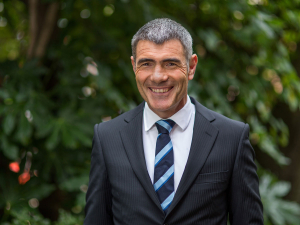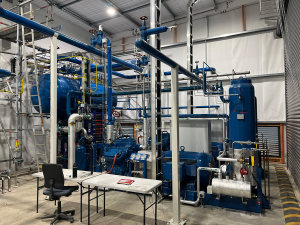The couple and five full-time staff manage 4,000 Headwaters ewes and 250 Angus cows on “The Wandle” and finish a further 20,000 trade lambs and 1,000 cattle annually for Lone Star Farms. The properties are owned by Nelson-based businessman Tom Sturgess.
The Barrs use the Tru- Test Fence Monitoring system to contain cattle and prime lambs on the property. A leader-follower system of rotational grazing is used across the pasture areas of the operation, with lambs going in front to extract optimal nutrition from the pasture, and cattle following to mop up any worms and maintain pasture quality.
Tara says the ability to monitor electric fencing via mobile phone provides peace of mind for livestock welfare as it ensures a quick response to any faults.
“We pursued a fence monitoring system to help manage the power for our extensive electric fence system,” she explains.
“The Tru-Test fence monitoring system is particularly useful at this time of year when we’re grazing around 70% of our stock on brassica crops, which we need to monitor the consumption of closely.”
She adds that the system allows the team to see a short straight away instead of waiting until there’s a few to do and spending half a day tidying up.
“It means we keep the fences going better and maintain higher voltages. The app is the number one way to look at it.”
In addition to fodder beet, The Wandle grows kale and swedes for feeding in winter with some rye corn. Irrigated areas have a mixture of ryegrass and clover swards, lucerne and other forage crops, which are complemented by fescue-cocksfoot- clover mixes on the dryland country. Chicory is also grown as a specialist finishing crop for lambs from the NZ composite Headwaters breed, to boost the flavouring and level of Omega 3 fatty acids in their meat.
The Barrs are currently running six energisers for electric fencing across 2,000 hectares and have set up 15 Tru-Test nodes 500 metres apart within line of sight. With good phone reception across 90% of the property, accessing the app is not a problem.
“It has been working fine without any glitches,” Angus says. “The other day I was in town 100km away and a notification came up that four of the nodes had dropped voltage. I rang one of the guys, asked what had just changed, and he had it fixed in 10 minutes.”
He says, otherwise it could’ve taken a few hours to pick up.
“The same happened when the power went out and we weren’t in the house to realise there was no electricity. The app notified us straight away that the gateway and nodes were offline, so we immediately put a generator on the energisers.”
Barr says the system helps to narrow down the fault-finding as well, especially where the issue may be within a five or six paddock radius – it saves driving the whole fence line.
“We also have a lot of four and five-wire electric fences where we have a bit of a problem with grass growing up through them, that we spray out,” he adds.
“The monitoring system doesn’t help with that but it does tell us if there’s a short so we can get onto it immediately.”
According to Barr, the installation was easy – with Datamars Livestock representatives coming to The Wandle to set up and activate the nodes and ensure the system was downloaded to their phones.
He says another advantage is the ability to use Tru-Test Fence Monitoring on any fencing system.
“That means we don’t have to fork out thousands of dollars for new energizers, which wouldn’t be a small investment,” Barr explains.
“It’s also good that it’s so portable. We’ve taken a node off a permanent fence that isn’t used much at this time of year and put it on one of the temporary cropping fences that gets moved every day.”
He says the system offered unlimited possibilities.
“I recommend the Tru-Test system because it provides peace of mind, and because the nodes and the Gateways have been designed within a network so there could be opportunities in the future to add more systems for monitoring livestock and other resources.”

















